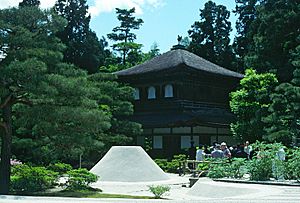Bunmei facts for kids
The Bunmei (error: {{nihongo}}: Japanese or romaji text required (help)) was a special time period in Japanese history. It was an "era name" (called nengō in Japanese). This era came after the Ōnin period and before the Chōkyō period. The Bunmei era started in April 1469 and ended in July 1487. During this time, the emperor of Japan was Go-Tsuchimikado-tennō (後土御門天皇).
Important Events of the Bunmei Era
Many interesting things happened during the Bunmei era:
- January 18, 1471 (Bunmei 2): The former-Emperor Go-Hanazono passed away. He was 52 years old. A "former-Emperor" is an emperor who has retired from his role.
- April 16, 1473 (Bunmei 5): Yamana Sōzen died at the age of 70. He was a very powerful leader during this time.
- 1478 (Bunmei 10): A famous thinker named Ichijō Kanera (who lived from 1402 to 1481) wrote a book. It was called Bummei ittō-ki. This book was about how knowledge and culture should be connected. It also talked about good ways to lead a country.
- February 21, 1482 (Bunmei 14): Construction began on a famous building. This was the Silver Pavilion, also known as "Silver Temple." It was started by Ashikaga Yoshimasa, who was a powerful military leader called a shogun.
- 1484 (Bunmei 16): The Ginkaku-ji or "Silver Pavilion" was built. It became a beautiful landmark.
Related Information
- Muromachi period: The Bunmei era was part of this larger historical period in Japan.
- You can learn more about the Japanese calendar and its history here: National Diet Library, "The Japanese Calendar".

All content from Kiddle encyclopedia articles (including the article images and facts) can be freely used under Attribution-ShareAlike license, unless stated otherwise. Cite this article:
Bunmei Facts for Kids. Kiddle Encyclopedia.

